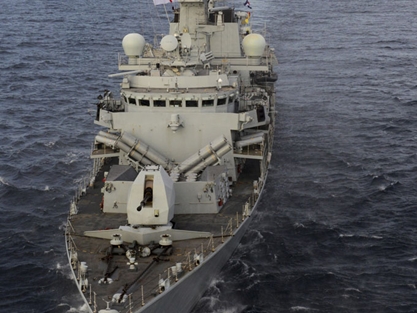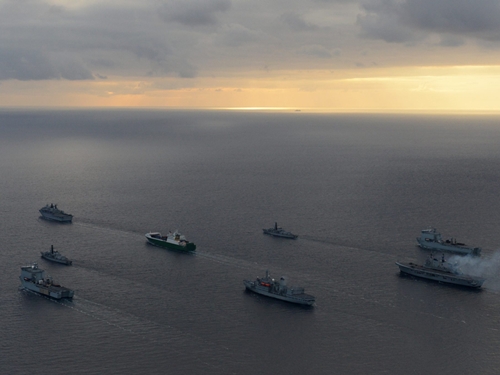
29/08/2013
A Royal Navy warship has played a game of cat-and-mouse as part of a high-tempo exercise in the Mediterranean with the Hellenic Navy. HMS Montrose and HS Kanaris took turns to hunt each other down in the dead of night using their respective passive detection systems, finding it equally difficult to track one another.It brought home to me how similarly our navies work and how much we have in common. It is an experience I will remember for a long timeLieutenant Chris Poulson
Once the ships had found their
targets they then used their anti-surface weapons and held a simulated
missile firing to practise obliterating their opponent.
This was followed by a number of complex communications serials, ranging from Morse code using flashing lights, to tactical command voice procedures, and electronic warfare.
HMS Montrose’s Lynx Mark 8 helicopter also managed to fit in some training and held a winching exercise with Lieutenant Chris Poulson who was transferred to HS Kanaris as part of an exchange with their counterpart - Lt Giannis Mpikakis.
This enable both officers to witness life on each other’s ships with Lt Mpikakis able to watch the large firing serial from HMS Montrose which bombarded the island of Megalo Nisaki; a specially designated safe area for such exercises.
He said:
“It has been a great experience to see Montrose operate with the Kanaris, I am especially impressed with the operation of the medium range gun.”
The bombardment of Megalo Nisaki was guided using the Lynx helicopter which acted as the aerial spotting platform.
Embarked in the helicopter were members of 148 Battery from 29 Commando Regiment Royal Artillery, an affiliate unit to HMS Montrose, who passed accuracy reports and firing corrections to the ships.
HS Kanaris, using her Oto Malara 3 inch gun, was first on the range and demonstrated superb accuracy and rate of fire, completing her missions without fault.
HMS Montrose used her 4.5 inch gun into action. After 60 rounds of high explosives all missions were complete and all targets had been destroyed.
Once back on board HMS Montrose, Lt Paulson, who is from Mickleton, Gloucestershire, added:
“I was made very welcome by our Greek allies, and was very impressed by the professionalism and attitude of everyone I met on board.
"It brought home to me how similarly our navies work and how much we have in common. It is an experience I will remember for a long time.”
 The war fighting game came as part of the Royal Navy’s Cougar 13
deployment which is made up for four Royal Navy warships and five
support vessels called the Response Force Task Group (RFTG).
The war fighting game came as part of the Royal Navy’s Cougar 13
deployment which is made up for four Royal Navy warships and five
support vessels called the Response Force Task Group (RFTG).
This also includes the Lead Commando Group (LCG) of 42 Commando – the Royal Marine unit that stands ready to react to events anywhere in the world.
Commanded by Commodore Paddy McAlpine, the RFTG is the UK’s high readiness maritime force, made up of ships, submarines, aircraft and the LCG, which is at five days notice to act in response to any contingency tasking including humanitarian disaster relief or international military intervention.
The four month Cougar deployment is the annual work-out for the units involved, and sees them working with partner nations throughout the Mediterranean, Red Sea, Arabian Gulf, and Horn of Africa.
Commander James Parkin, Commanding Officer HMS Montrose said:
“It has been a privilege to work with the HS Kanaris and to prove, unequivocally, that we are able to interoperate at an advanced level with the Hellenic Navy, especially as Greece is such an important partner to the UK. I look forward to further working with them in the future."
Follow the Royal Navy on Facebook
This was followed by a number of complex communications serials, ranging from Morse code using flashing lights, to tactical command voice procedures, and electronic warfare.
HMS Montrose’s Lynx Mark 8 helicopter also managed to fit in some training and held a winching exercise with Lieutenant Chris Poulson who was transferred to HS Kanaris as part of an exchange with their counterpart - Lt Giannis Mpikakis.
This enable both officers to witness life on each other’s ships with Lt Mpikakis able to watch the large firing serial from HMS Montrose which bombarded the island of Megalo Nisaki; a specially designated safe area for such exercises.
He said:
“It has been a great experience to see Montrose operate with the Kanaris, I am especially impressed with the operation of the medium range gun.”
The bombardment of Megalo Nisaki was guided using the Lynx helicopter which acted as the aerial spotting platform.
Embarked in the helicopter were members of 148 Battery from 29 Commando Regiment Royal Artillery, an affiliate unit to HMS Montrose, who passed accuracy reports and firing corrections to the ships.
HS Kanaris, using her Oto Malara 3 inch gun, was first on the range and demonstrated superb accuracy and rate of fire, completing her missions without fault.
HMS Montrose used her 4.5 inch gun into action. After 60 rounds of high explosives all missions were complete and all targets had been destroyed.
Once back on board HMS Montrose, Lt Paulson, who is from Mickleton, Gloucestershire, added:
“I was made very welcome by our Greek allies, and was very impressed by the professionalism and attitude of everyone I met on board.
"It brought home to me how similarly our navies work and how much we have in common. It is an experience I will remember for a long time.”

This also includes the Lead Commando Group (LCG) of 42 Commando – the Royal Marine unit that stands ready to react to events anywhere in the world.
Commanded by Commodore Paddy McAlpine, the RFTG is the UK’s high readiness maritime force, made up of ships, submarines, aircraft and the LCG, which is at five days notice to act in response to any contingency tasking including humanitarian disaster relief or international military intervention.
The four month Cougar deployment is the annual work-out for the units involved, and sees them working with partner nations throughout the Mediterranean, Red Sea, Arabian Gulf, and Horn of Africa.
Commander James Parkin, Commanding Officer HMS Montrose said:
“It has been a privilege to work with the HS Kanaris and to prove, unequivocally, that we are able to interoperate at an advanced level with the Hellenic Navy, especially as Greece is such an important partner to the UK. I look forward to further working with them in the future."
Follow the Royal Navy on Facebook
Δεν υπάρχουν σχόλια:
Δημοσίευση σχολίου